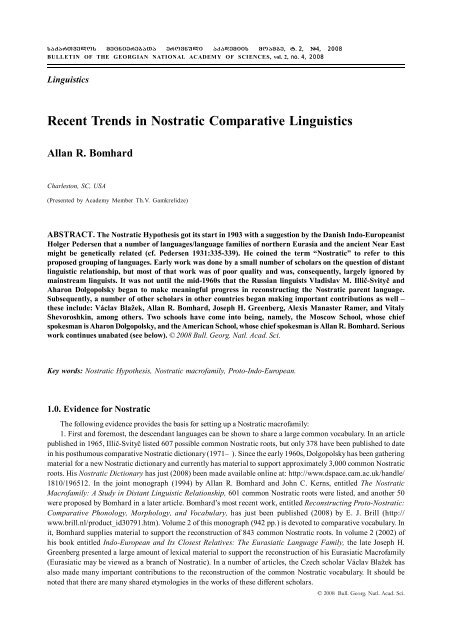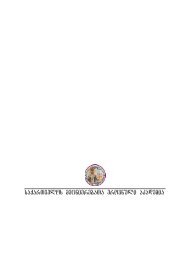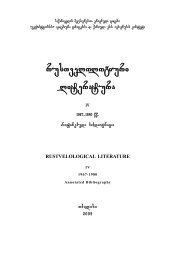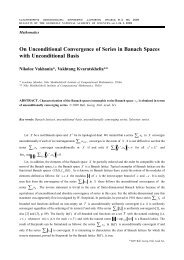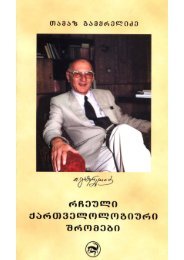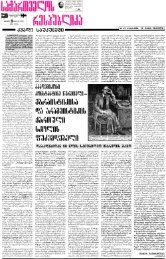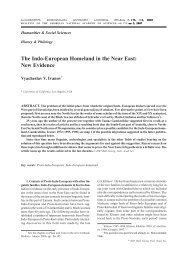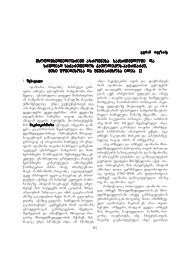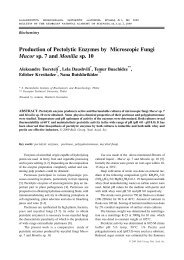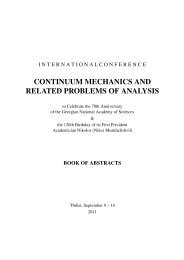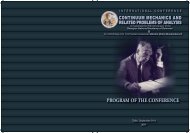Recent Trends in Nostratic Comparative Linguistics - The Georgian ...
Recent Trends in Nostratic Comparative Linguistics - The Georgian ...
Recent Trends in Nostratic Comparative Linguistics - The Georgian ...
Create successful ePaper yourself
Turn your PDF publications into a flip-book with our unique Google optimized e-Paper software.
saqarTvelos mecnierebaTa erovnuli akademiis moambe, t. 2, #4, 2008<br />
BULLETIN OF THE GEORGIAN NATIONAL ACADEMY OF SCIENCES, vol. 2, no. 4, 2008<br />
L<strong>in</strong>guistics<br />
<strong>Recent</strong> <strong>Trends</strong> <strong>in</strong> <strong>Nostratic</strong> <strong>Comparative</strong> L<strong>in</strong>guistics<br />
Allan R. Bomhard<br />
Charleston, SC, USA<br />
(Presented by Academy Member Th.V. Gamkrelidze)<br />
ABSTRACT. <strong>The</strong> <strong>Nostratic</strong> Hypothesis got its start <strong>in</strong> 1903 with a suggestion by the Danish Indo-Europeanist<br />
Holger Pedersen that a number of languages/language families of northern Eurasia and the ancient Near East<br />
might be genetically related (cf. Pedersen 1931:335-339). He co<strong>in</strong>ed the term “<strong>Nostratic</strong>” to refer to this<br />
proposed group<strong>in</strong>g of languages. Early work was done by a small number of scholars on the question of distant<br />
l<strong>in</strong>guistic relationship, but most of that work was of poor quality and was, consequently, largely ignored by<br />
ma<strong>in</strong>stream l<strong>in</strong>guists. It was not until the mid-1960s that the Russian l<strong>in</strong>guists Vladislav M. Illič-Svityč and<br />
Aharon Dolgopolsky began to make mean<strong>in</strong>gful progress <strong>in</strong> reconstruct<strong>in</strong>g the <strong>Nostratic</strong> parent language.<br />
Subsequently, a number of other scholars <strong>in</strong> other countries began mak<strong>in</strong>g important contributions as well –<br />
these <strong>in</strong>clude: Václav Blažek, Allan R. Bomhard, Joseph H. Greenberg, Alexis Manaster Ramer, and Vitaly<br />
Shevoroshk<strong>in</strong>, among others. Two schools have come <strong>in</strong>to be<strong>in</strong>g, namely, the Moscow School, whose chief<br />
spokesman is Aharon Dolgopolsky, and the American School, whose chief spokesman is Allan R. Bomhard. Serious<br />
work cont<strong>in</strong>ues unabated (see below). © 2008 Bull. Georg. Natl. Acad. Sci.<br />
Key words: <strong>Nostratic</strong> Hypothesis, <strong>Nostratic</strong> macrofamily, Proto-Indo-European.<br />
1.0. Evidence for <strong>Nostratic</strong><br />
<strong>The</strong> follow<strong>in</strong>g evidence provides the basis for sett<strong>in</strong>g up a <strong>Nostratic</strong> macrofamily:<br />
1. First and foremost, the descendant languages can be shown to share a large common vocabulary. In an article<br />
published <strong>in</strong> 1965, Illič-Svityč listed 607 possible common <strong>Nostratic</strong> roots, but only 378 have been published to date<br />
<strong>in</strong> his posthumous comparative <strong>Nostratic</strong> dictionary (1971– ). S<strong>in</strong>ce the early 1960s, Dolgopolsky has been gather<strong>in</strong>g<br />
material for a new <strong>Nostratic</strong> dictionary and currently has material to support approximately 3,000 common <strong>Nostratic</strong><br />
roots. His <strong>Nostratic</strong> Dictionary has just (2008) been made available onl<strong>in</strong>e at: http://www.dspace.cam.ac.uk/handle/<br />
1810/196512. In the jo<strong>in</strong>t monograph (1994) by Allan R. Bomhard and John C. Kerns, entitled <strong>The</strong> <strong>Nostratic</strong><br />
Macrofamily: A Study <strong>in</strong> Distant L<strong>in</strong>guistic Relationship, 601 common <strong>Nostratic</strong> roots were listed, and another 50<br />
were proposed by Bomhard <strong>in</strong> a later article. Bomhard’s most recent work, entitled Reconstruct<strong>in</strong>g Proto-<strong>Nostratic</strong>:<br />
<strong>Comparative</strong> Phonology, Morphology, and Vocabulary, has just been published (2008) by E. J. Brill (http://<br />
www.brill.nl/product_id30791.htm). Volume 2 of this monograph (942 pp.) is devoted to comparative vocabulary. In<br />
it, Bomhard supplies material to support the reconstruction of 843 common <strong>Nostratic</strong> roots. In volume 2 (2002) of<br />
his book entitled Indo-European and Its Closest Relatives: <strong>The</strong> Eurasiatic Language Family, the late Joseph H.<br />
Greenberg presented a large amount of lexical material to support the reconstruction of his Eurasiatic Macrofamily<br />
(Eurasiatic may be viewed as a branch of <strong>Nostratic</strong>). In a number of articles, the Czech scholar Václav Blažek has<br />
also made many important contributions to the reconstruction of the common <strong>Nostratic</strong> vocabulary. It should be<br />
noted that there are many shared etymologies <strong>in</strong> the works of these different scholars.<br />
© 2008 Bull. Georg. Natl. Acad. Sci.
<strong>Recent</strong> <strong>Trends</strong> <strong>in</strong> <strong>Nostratic</strong> <strong>Comparative</strong> L<strong>in</strong>guistics 149<br />
2. As is to be expected, the various branches of <strong>Nostratic</strong> <strong>in</strong>vestigated to date exhibit regular sound correspondences<br />
(see the Appendix at the end of this paper for details), though, it should be mentioned, there are differences <strong>in</strong><br />
<strong>in</strong>terpretation between Illič-Svityč and Dolgopolsky on the one hand and Bomhard on the other (see below [§10.0]).<br />
3. F<strong>in</strong>ally, a substantial number of common grammatical formants have now been recovered – many of these are<br />
listed <strong>in</strong> Illič-Svityč’s comparative <strong>Nostratic</strong> dictionary (1971– ); see also Dybo (2004), the chapter on <strong>Nostratic</strong><br />
morphology by John C. Kerns <strong>in</strong> Bomhard–Kerns (1994:141–190), volume 1 of Greenberg’s Indo-European and Its<br />
Closest Relatives: <strong>The</strong> Eurasiatic Language Family (Greenberg 2000), and Chapters 16 and 17 of Bomhard’s new<br />
book Reconstruct<strong>in</strong>g Proto-<strong>Nostratic</strong> (Bomhard 2008.I:273–415).<br />
Notable among the lexical items uncovered by Illič-Svityč, Dolgopolsky, Greenberg, and Bomhard is a solid core of<br />
common pronom<strong>in</strong>al stems. <strong>The</strong>se pronom<strong>in</strong>al stems have particular importance, s<strong>in</strong>ce, as forcefully demonstrated by<br />
John C. Kerns (1985:9–50), pronouns, be<strong>in</strong>g among the most stable elements of a language, are a particularly strong<br />
<strong>in</strong>dicator of genetic relationship (Ruhlen 1994:92–93 makes the same po<strong>in</strong>t, as did Björn Coll<strong>in</strong>der before him).<br />
<strong>The</strong> conclusion seems <strong>in</strong>escapable that the consistent, regular phonological correspondences that can be shown<br />
to exist among the <strong>Nostratic</strong> daughter languages as well as the agreements <strong>in</strong> vocabulary and grammatical formants<br />
that have been uncovered to date cannot be expla<strong>in</strong>ed as due to l<strong>in</strong>guistic borrow<strong>in</strong>g or mere chance but can only be<br />
accounted for <strong>in</strong> terms of common orig<strong>in</strong>, that is, genetic relationship. To assume any other possibility would be<br />
tantamount to deny<strong>in</strong>g the efficacy of the <strong>Comparative</strong> Method. This does not mean that all problems have been<br />
solved. On the contrary, there rema<strong>in</strong> many issues to be <strong>in</strong>vestigated and many details to be worked out, but the future<br />
looks extremely excit<strong>in</strong>g and extremely promis<strong>in</strong>g.<br />
2.0. <strong>Nostratic</strong> Homeland<br />
Analysis of the available evidence has enabled us to determ<strong>in</strong>e the most likely homeland of the <strong>Nostratic</strong> parent<br />
language, to establish a time-frame dur<strong>in</strong>g which Proto-<strong>Nostratic</strong> might have been spoken, to date the dis<strong>in</strong>tegration<br />
of Proto-<strong>Nostratic</strong>, and to trace the early dispersal of the daughter languages. <strong>The</strong> follow<strong>in</strong>g scenario emerges: <strong>The</strong><br />
unified <strong>Nostratic</strong> parent language may be dated to between 15,000 to 12,000 BCE, that is, at the end of the last Ice<br />
Age – it was most likely located <strong>in</strong> the Fertile Crescent just south of the Caucasus Mounta<strong>in</strong>s. Beg<strong>in</strong>n<strong>in</strong>g around<br />
12,000 BCE, <strong>Nostratic</strong> began to expand, and, by 10,000 BCE, several dist<strong>in</strong>ct dialect groups had appeared. <strong>The</strong> first<br />
to split off from the ma<strong>in</strong> speech community was Afrasian. One dialect group spread from the Fertile Crescent to the<br />
northeast, eventually reach<strong>in</strong>g Central Asia sometime before 9,000 BCE – this was Eurasiatic. Another dialect group<br />
spread eastward <strong>in</strong>to western and central Iran, where it developed <strong>in</strong>to Elamo-Dravidian at about 8,000 BCE. If<br />
Johanna Nichols is correct <strong>in</strong> see<strong>in</strong>g Pre-Proto-Kartvelian as hav<strong>in</strong>g migrated from Central Asia westward below the<br />
Caspian Sea to the Caucasus, this would seem to imply that Pre-Proto-Kartvelian had first migrated northeastward<br />
from the Fertile Crescent along with or as part of Pre-Proto-Eurasiatic, that it stopped somewhere along the way, and<br />
that it then returned to the Middle East. For details, cf. Dolgopolsky 1998 and Bomhard 2008.1:221–252.<br />
<strong>The</strong> follow<strong>in</strong>g map shows the approximate location of the <strong>Nostratic</strong> homeland around 15,000 BCE:<br />
Bull. Georg. Natl. Acad. Sci., vol. 2, no. 4, 2008
150 Allan R. Bomhard<br />
At this stage of research, we can confidently say that the follow<strong>in</strong>g languages/language families are to be <strong>in</strong>cluded<br />
<strong>in</strong> the <strong>Nostratic</strong> macrofamily: Afrasian (also called Afroasiatic, Hamito-Semitic, Semito-Hamitic), Elamo-Dravidian,<br />
Kartvelian, and Eurasiatic. Eurasiatic, <strong>in</strong> turn, <strong>in</strong>cludes the follow<strong>in</strong>g: Tyrrhenian (Etruscan, Raetic, and Lemnian), Indo-<br />
European, Uralic-Yukaghir, Altaic (Mongolian, Turkic, and Tungus), Chukchi-Kamchatkan, Gilyak (also called Nivkh),<br />
and Eskimo-Aleut. Other languages may belong as well, such as, for example, Korean and Japonic (Japanese-Ryukyuan).<br />
But much work needs to be done before these two groups can be conv<strong>in</strong>c<strong>in</strong>gly shown to be related to Altaic (itself quite<br />
controversial), as is often assumed, let alone <strong>Nostratic</strong>.<br />
3.0. A Sketch of Proto-<strong>Nostratic</strong> Phonology<br />
Proto-<strong>Nostratic</strong> had a rich system of stops and affricates. Each stop and affricate series was characterized by the<br />
three-way contrast (1) voiceless (aspirated), (2) voiced, and (3) glottalized. <strong>The</strong> aspiration of series (1) was phonemically<br />
non-dist<strong>in</strong>ctive.<br />
<strong>The</strong> Proto-<strong>Nostratic</strong> phonological system may tentatively be reconstructed as follows (cf. Bomhard 2008.1:213–<br />
220; see Dolgopolsky 1998:101 for a slightly different reconstruction):<br />
3.1. Remarks on the Vowels<br />
<strong>The</strong> follow<strong>in</strong>g vowels may be reconstructed for Proto-<strong>Nostratic</strong>: *a, *e, *i, *o, and *u. At least some of these<br />
vowels must have been subject to considerable subphonemic variation <strong>in</strong> the <strong>Nostratic</strong> parent language. <strong>The</strong> high<br />
front and back vowels *i and *u, <strong>in</strong> particular, may be assumed to have had lowered variants (<strong>in</strong>dicated <strong>in</strong> the Proto-<br />
<strong>Nostratic</strong> reconstructions as *e and *o respectively), while the central low vowel *a may be assumed to have had<br />
higher variants (<strong>in</strong>dicated <strong>in</strong> the Proto-<strong>Nostratic</strong> reconstructions as *@). To complicate matters, *e and *o must also<br />
have existed as <strong>in</strong>dependent vocalic elements. It was the reanalysis, phonemicization, and exploitation of this<br />
subphonemic variation that gave rise to the ablaut and vowel harmony pattern<strong>in</strong>g found <strong>in</strong> the majority of the<br />
Bull. Georg. Natl. Acad. Sci., vol. 2, no. 4, 2008
<strong>Recent</strong> <strong>Trends</strong> <strong>in</strong> <strong>Nostratic</strong> <strong>Comparative</strong> L<strong>in</strong>guistics 151<br />
<strong>Nostratic</strong> daughter languages. It may be noted here that, accord<strong>in</strong>g to Greenberg (1990), traces of an earlier system of<br />
vowel harmony can be discerned <strong>in</strong> Proto-Indo-European.<br />
It is unclear whether phonemic long vowels existed <strong>in</strong> Proto-<strong>Nostratic</strong> as well, though the evidence seems to<br />
<strong>in</strong>dicate that they did not, except <strong>in</strong> nursery words.<br />
F<strong>in</strong>ally, it may be noted that, while any vowel (*a, *e, *i, *o, *u) could appear <strong>in</strong> <strong>in</strong>itial syllables, only *a, *i, *u<br />
could appear <strong>in</strong> non-<strong>in</strong>itial syllables. This is identical to the pattern<strong>in</strong>g found <strong>in</strong> Dravidian.<br />
4.0. Root Structure Pattern<strong>in</strong>g <strong>in</strong> Proto-<strong>Nostratic</strong><br />
Comparison of the various <strong>Nostratic</strong> daughter languages makes it possible to determ<strong>in</strong>e the rules govern<strong>in</strong>g the<br />
structural pattern<strong>in</strong>g of roots and stems <strong>in</strong> Proto-<strong>Nostratic</strong>. Most likely, the earliest pattern<strong>in</strong>g was as follows (cf.<br />
Bomhard 2008.1:215–216 and 1:391–394):<br />
1. <strong>The</strong>re were no <strong>in</strong>itial vowels <strong>in</strong> Proto-<strong>Nostratic</strong>. <strong>The</strong>refore, every root began with a consonant.<br />
2. Orig<strong>in</strong>ally, there were no <strong>in</strong>itial consonant clusters either. Consequently, every root began with one and only<br />
one consonant. Medial clusters were permitted, however.<br />
3. Two basic root types existed: (A) *CV and (B) *CVC, where C = any non-syllabic, and V =any vowel. Permissible<br />
root forms co<strong>in</strong>cided exactly with these two syllable types.<br />
4. A stem could either be identical with a root or it could consist of a root plus a s<strong>in</strong>gle derivational morpheme<br />
added as a suffix to the root: *CVC+CV-. Any consonant could serve as a suffix.<br />
5. A stem could thus assume any one of the follow<strong>in</strong>g shapes: (A) *CV-, (B) *CVC-, (C) *CVC+CV-, or (D)<br />
*CVC-CVC-. As <strong>in</strong> Proto-Altaic, the undifferentiated stems were real words <strong>in</strong> themselves and could be used without<br />
additional suffixes or grammatical end<strong>in</strong>gs. However, when so used, a vowel had to be added to the stem (unless the<br />
stem already ended <strong>in</strong> a vowel or <strong>in</strong> a semivowel, nasal, or liquid), thus: (A) *CV- > *CV (no change), (B) *CVC- ><br />
*CVC+V, (C) *CVC-CV- > (no change), or (D) *CVC-CVC- > *CVC-CVC+V. Follow<strong>in</strong>g Afrasian term<strong>in</strong>ology, this<br />
vowel may be called a “term<strong>in</strong>al vowel” (TV). Not only did term<strong>in</strong>al vowels exist <strong>in</strong> Proto-Afrasian, they were also<br />
found <strong>in</strong> Dravidian, where they are called “enunciative vowels”. As <strong>in</strong> Proto-Dravidian, the term<strong>in</strong>al vowel was only<br />
required <strong>in</strong> stems end<strong>in</strong>g <strong>in</strong> obstruents, which could not occur <strong>in</strong> f<strong>in</strong>al position.<br />
<strong>The</strong> orig<strong>in</strong>al root structure pattern<strong>in</strong>g was ma<strong>in</strong>ta<strong>in</strong>ed longer <strong>in</strong> Proto-Dravidian and Proto-Altaic than <strong>in</strong> the<br />
other branches, while the pattern<strong>in</strong>g found <strong>in</strong> Proto-Indo-European, Proto-Kartvelian, and Proto-Afrasian is based<br />
upon slightly later developments. <strong>The</strong> root structure constra<strong>in</strong>ts found <strong>in</strong> Proto-Indo-European were an <strong>in</strong>novation.<br />
In Proto-Uralic, the rule requir<strong>in</strong>g that all words end <strong>in</strong> a vowel was an <strong>in</strong>novation and arose from the <strong>in</strong>corporation<br />
of the so-called “term<strong>in</strong>al vowel” <strong>in</strong>to the stem. It should be mentioned that reduplication was a widespread phenomenon.<br />
On the basis of the evidence of Proto-Indo-European, Proto-Kartvelian, Proto-Afrasian, Proto-Dravidian, and<br />
Proto-Altaic, it may be assumed that there were three fundamental stem types: (A) verbal stems, (B) nom<strong>in</strong>al and<br />
adjectival stems, and (C) pronom<strong>in</strong>al and <strong>in</strong>decl<strong>in</strong>able stems. Some stems were exclusively nom<strong>in</strong>al. In the majority<br />
of cases, however, both verbal stems and nom<strong>in</strong>al stems could be built from the same root. In Proto-<strong>Nostratic</strong>, only<br />
pronom<strong>in</strong>al and <strong>in</strong>decl<strong>in</strong>able stems could end <strong>in</strong> a vowel. Verbal and nom<strong>in</strong>al stems, on the other hand, had to end <strong>in</strong><br />
a consonant, though, as noted above, when the undifferentiated stems were used as real words <strong>in</strong> themselves, a<br />
“term<strong>in</strong>al vowel” had to be added to the stem (but only when the stem ended <strong>in</strong> an obstruent). <strong>The</strong> term<strong>in</strong>al vowels<br />
were morphologically significant. Adjectives did not exist as an <strong>in</strong>dependent grammatical category <strong>in</strong> Proto-<strong>Nostratic</strong>.<br />
Dur<strong>in</strong>g the earliest period of Proto-<strong>Nostratic</strong>, roots could only have the forms: (A) *CV- and (B) *CVC-. Type<br />
(A) was restricted to pronom<strong>in</strong>al stems and <strong>in</strong>decl<strong>in</strong>ables, while type (B) characterized nom<strong>in</strong>al and verbal stems. A<br />
s<strong>in</strong>gle derivational formative could be placed after root type (B): *CVC + CV (derivational formative). Grammatical<br />
relationships were <strong>in</strong>dicated by plac<strong>in</strong>g particles either after the undifferentiated stem or after the stem plus a derivational<br />
formative: (A) *CVC + CV (particle [P]) or (B) *CVC + CV (derivational formative [DF]) + CV (particle<br />
[P]). In this scheme, a morphologically significant formative vowel (FV) had to be added either directly after the root<br />
if it ended <strong>in</strong> a consonant or between the root and any follow<strong>in</strong>g element, be it particle or derivational formative;<br />
thus, we get the follow<strong>in</strong>g patterns:<br />
(A) *CVC + V FV<br />
(plus particle: *CVC + V FV<br />
+ CV P<br />
)<br />
(B) *CVC + V FV<br />
+ CVDF (plus particle: *CVC + V FV<br />
+ CV DF<br />
+ CV P<br />
)<br />
(C) *CVC-CVC + V FV<br />
(plus particle: *CVC-CVC + V FV<br />
+ CV P<br />
)<br />
Bull. Georg. Natl. Acad. Sci., vol. 2, no. 4, 2008
152 Allan R. Bomhard<br />
Eventually, the vowel of the derivational formative after the stem plus formative vowel was lost <strong>in</strong> type (B) when a<br />
particle was added, as follows: *CVC + V FV<br />
+ C DF<br />
+ CV P<br />
. This is essentially the stage represented <strong>in</strong> Proto-Dravidian,<br />
though Proto-Dravidian has added long vowels to the equation as well as stems beg<strong>in</strong>n<strong>in</strong>g with a vowel (no doubt<br />
aris<strong>in</strong>g from the loss of <strong>in</strong>itial laryngeals). Next, the formative vowel was re<strong>in</strong>terpreted as part of the derivational<br />
formative <strong>in</strong> type (B): *CVC + VC + CV. This is the stage represented by Proto-Afrasian and is the basis for the root<br />
structure pattern<strong>in</strong>g found <strong>in</strong> Proto-Kartvelian and Proto-Indo-European as well. From an Afrasian perspective, there is<br />
no such th<strong>in</strong>g as “formative vowels” – they are only preserved <strong>in</strong> Dravidian and Elamite, though, <strong>in</strong> Elamite, their status<br />
is disputed.<br />
5.0. Proto-<strong>Nostratic</strong> Morphology<br />
<strong>The</strong> assumptions we make about the morphological and syntactical structure of a given proto-language profoundly<br />
affect the reconstructions that we propose. In what follows, we will be discuss<strong>in</strong>g Bomhard’s proposal<br />
(2008.1:387–391) that Proto-<strong>Nostratic</strong> may have been an active language. Now, active languages exhibit specific<br />
characteristics that set them apart from other morphological types. <strong>The</strong>refore, the reconstructions given below will<br />
conform with an active structure. However, it must be stressed that reconstructions should never be driven by theory<br />
alone. Rather, they must be fully consistent with the support<strong>in</strong>g data. Moreover, not only must our reconstructions be<br />
consistent with the support<strong>in</strong>g data, they must be consistent from a typological perspective as well, and they must be<br />
able to account for later developments <strong>in</strong> the descendant languages <strong>in</strong> as straightforward a manner as possible,<br />
without recourse to ad hoc rules. When reconstructions are driven by theory alone, the results can be disastrous.<br />
Several scholars have recently presented persuasive arguments <strong>in</strong> favor of reconstruct<strong>in</strong>g an early phase of<br />
Proto-Indo-European as an active language. Proto-Afrasian is also assumed to have been an active language. In<br />
active languages, subjects of both transitive and <strong>in</strong>transitive verbs, when they are agents semantically, are treated<br />
identically for grammatical purposes, while non-agent subjects and direct objects are treated differently. An “agent”<br />
may be def<strong>in</strong>ed as the entity responsible for a particular action or the entity perceived to be the cause of an action.<br />
Above, we mentioned that Proto-<strong>Nostratic</strong> had formative vowels. Now, it is curious that the formative vowel can<br />
take different shapes <strong>in</strong> Proto-Dravidian: *a, *i, or *u. This seems to <strong>in</strong>dicate that the different formative vowels<br />
must have had some sort of morphological significance at one po<strong>in</strong>t <strong>in</strong> time, even though this dist<strong>in</strong>ction has been<br />
lost <strong>in</strong> Dravidian. Not only must the formative vowels have had morphological significance, it is even probable that<br />
they had different significance depend<strong>in</strong>g upon whether a nom<strong>in</strong>al or verbal stem was <strong>in</strong>volved.<br />
For verbal stems, the formative vowels may have been aspect markers, as follows: *a marked imperfective, *i<br />
marked perfective, and *u marked subord<strong>in</strong>ate.<br />
For nom<strong>in</strong>al stems, the situation is a bit more complicated. <strong>The</strong> follow<strong>in</strong>g pattern<strong>in</strong>g may be reconstructed for<br />
the earliest period of development <strong>in</strong> Proto-<strong>Nostratic</strong>: *-i/*-u was used to mark the subject <strong>in</strong> active constructions,<br />
while *-a was used to mark the direct object <strong>in</strong> active constructions as well as the subject <strong>in</strong> stative constructions.<br />
*-a was also used to mark the so-called “status <strong>in</strong>determ<strong>in</strong>atus”.<br />
In later Proto-<strong>Nostratic</strong>, this pattern<strong>in</strong>g became disrupted, though it may have survived <strong>in</strong>to Proto-Afrasian. In later<br />
Proto-<strong>Nostratic</strong>, the relational markers *-ma and *-na came to be used to mark the direct object <strong>in</strong> active constructions<br />
as well as the subject <strong>in</strong> stative constructions. Eventually, these relational markers became the primary means of<br />
mark<strong>in</strong>g the direct object <strong>in</strong> active constructions or the subject <strong>in</strong> stative constructions, with the result that the older<br />
pattern<strong>in</strong>g became disrupted. Thus, <strong>in</strong> the latest stage of the <strong>Nostratic</strong> parent language, we f<strong>in</strong>d the follow<strong>in</strong>g pattern<strong>in</strong>g:<br />
1. *-i/*-u: used to mark the subject <strong>in</strong> active constructions:<br />
(A) *CVC + i/u<br />
(B) *CVC + i/u + CVDF<br />
(C) *CVC-CVC + i/u<br />
2. *-a ~ *-ma/*-na: used to mark the direct object <strong>in</strong> active constructions as well as the subject <strong>in</strong> stative<br />
constructions:<br />
(A) *CVC + a<br />
plus *-ma/*-na: *CVC + a + ma/na<br />
(B) *CVC + a + CV DF<br />
plus *-ma/*-na: *CVC + a + C(V) DF<br />
+ ma/na<br />
(C) *CVC-CVC + a<br />
plus *-ma/*-na: *CVC-CVC + a + ma/na<br />
Bull. Georg. Natl. Acad. Sci., vol. 2, no. 4, 2008
<strong>Recent</strong> <strong>Trends</strong> <strong>in</strong> <strong>Nostratic</strong> <strong>Comparative</strong> L<strong>in</strong>guistics 153<br />
*-ma/*-na was the first case form (bound relational marker) to develop <strong>in</strong> Proto-<strong>Nostratic</strong>. <strong>The</strong> second was the genitive<br />
(<strong>in</strong> the sense ‘belong<strong>in</strong>g to’) <strong>in</strong> *-nu. Indeed, these are the only two bound relational markers that can be confidently<br />
reconstructed for the latest period of Proto-<strong>Nostratic</strong>. F<strong>in</strong>ally, it seems likely that unextended *-a rema<strong>in</strong>ed as the<br />
<strong>in</strong>dicator of the status <strong>in</strong>determ<strong>in</strong>atus.<br />
Proto-<strong>Nostratic</strong> syntax was head-f<strong>in</strong>al, or left-branch<strong>in</strong>g, that is, dependents preceded their heads accord<strong>in</strong>g to<br />
the so-called “rectum-regens rule”. In other words, “adverbs” preceded verbs, “adjectives” preceded nouns, and<br />
auxiliaries followed the ma<strong>in</strong> verb, though it must be emphasized here that adjectives did not exist as an <strong>in</strong>dependent<br />
grammatical category <strong>in</strong> Proto-<strong>Nostratic</strong>. <strong>The</strong> unmarked syntactical order was Subject + Object + Verb (SOV).<br />
6.0. Pronom<strong>in</strong>al, Deictic, and Anaphoric Stems<br />
6.1. First Person Stems<br />
First person s<strong>in</strong>gular (active): *mi<br />
First person plural (<strong>in</strong>clusive, active): *ma<br />
First person (stative): *k h a<br />
First person (stative): *Ha<br />
First person s<strong>in</strong>gular: *na<br />
First person plural (exclusive, active): *na<br />
First person (postnom<strong>in</strong>al possessive/preverbal agentive): * iya<br />
6.2. Second Person Stems<br />
Second person (active): *t h i (~ * t h a)<br />
Second person: *si<br />
Second person: *ni<br />
6.3. Anaphoric and Deictic Stems<br />
Pronom<strong>in</strong>al base of unclear deictic function: *-gi/*-ge<br />
Deictic particle: (A) * a-/* {- (distant), (B) * i-/* e- (proximate), and (C) * u-/* o- (<strong>in</strong>termediate)<br />
Deictic particle: (A) *k h a-/*k h {- (proximate), (B) *k h u-/*k h o- (distant), and (C) *k h i-/*k h e- (<strong>in</strong>termediate)<br />
Deictic particle: (A) *t h a-/*t h {- (proximate), (B) *t h u-/*t h o- (distant), and (C) *t h i-/*t h e- (<strong>in</strong>termediate)<br />
Deictic particle: *ša-/*s{-<br />
Anaphoric pronoun stem: *si-/*se-<br />
Anaphoric pronoun stem: *na-, *ni-<br />
Deictic particle: *t yh a- ‘that over there, that yonder (not very far)’<br />
6.4. Interrogative, Relative, and Indef<strong>in</strong>ite Stems<br />
Relative: *k wh i-/*k wh e-; <strong>in</strong>terrogative: *k wh a-/*k wh {-<br />
Interrogative-relative stem: * ay-, * ya-<br />
Interrogative: *mi-; relative: *ma-<br />
Interrogative-relative: *na-<br />
Indef<strong>in</strong>ite: *ma-, *mi-, *mu-<br />
Indef<strong>in</strong>ite: *d y i-/*d y e- ‘this one, that one’<br />
7.0. Nom<strong>in</strong>al Morphology<br />
<strong>The</strong> overall structure of nom<strong>in</strong>als (nouns and adjectives) was as follows:<br />
Root + formative vowel (+ derivational suffix)<br />
(+ relational marker) (+ number marker)<br />
A stem could consist of the unextended root or the root extended by a s<strong>in</strong>gle derivational suffix (preceded, as<br />
<strong>in</strong>dicated above, by a formative vowel). As has already been noted, it is necessary to recognize two dist<strong>in</strong>ct periods of<br />
development <strong>in</strong> Proto-<strong>Nostratic</strong>. In the earliest phase of development, the relational markers listed below were free<br />
relational morphemes (postpositional particles). In later Proto-<strong>Nostratic</strong>, however, at least two of them were well on<br />
their way to becom<strong>in</strong>g bound relational morphemes (case suffixes).<br />
Bull. Georg. Natl. Acad. Sci., vol. 2, no. 4, 2008
154 Allan R. Bomhard<br />
As already noted, only the follow<strong>in</strong>g two bound relational markers (case suffixes) can be confidently reconstructed<br />
for the latest period of Proto-<strong>Nostratic</strong>: (A) direct object *-ma, *-na and (B) genitive *-nu. Other case relationships were<br />
expressed by postpositions (see below for a list), some of which developed <strong>in</strong>to bound case morphemes <strong>in</strong> the <strong>in</strong>dividual<br />
daughter languages. This is confirmed by Dravidian, where only the accusative (*-ay, *-Vn), dative (*-kk-/*-k-),<br />
and genitive (*-a, *-<strong>in</strong>) can be confidently reconstructed for the Dravidian parent language. Other case forms developed<br />
with<strong>in</strong> the Dravidian daughter languages. Likewise, only the follow<strong>in</strong>g two grammatical cases can be reconstructed<br />
for Proto-Uralic: (A) accusative *-m, which probably was used to mark the def<strong>in</strong>ite direct object of f<strong>in</strong>ite verbs,<br />
and (B) a subord<strong>in</strong>ate suffix *-n, which functioned as a genitive/nom<strong>in</strong>alizer with nouns and as an adverb formant with<br />
verbs. <strong>The</strong>re were also at least three local cases <strong>in</strong> Proto-Uralic: (A) locative *-nA, (B) separative *-tA ~ *-tI, and (C) and<br />
perhaps the latives *-k (and/or *-à) and *- t y (traditional *-ć) (and/or *-n y [traditional *-ń]). Denis S<strong>in</strong>or (1988:714–725)<br />
has devoted an important study to the question of common case markers between Uralic and Altaic. He, too, posits a<br />
Proto-Uralic accusative <strong>in</strong> *-m and a genitive <strong>in</strong> *-n. For the former, he notes that noth<strong>in</strong>g comparable can be posited for<br />
Proto-Turkic or Proto-Mongolian, but he does reconstruct a Proto-Tungus accusative *-m, which is <strong>in</strong> agreement with<br />
what is found <strong>in</strong> Uralic. <strong>The</strong> clearest parallels for the latter are to be found <strong>in</strong> the Proto-Mongolian genitive *-n and <strong>in</strong><br />
the Proto-Turkic genitive *-n. <strong>The</strong> genitive and accusative have converged <strong>in</strong> some Mongolian languages. This seems<br />
to <strong>in</strong>dicate that Proto-Mongolian may have preserved the *-n variant accusative form as opposed to the *-m variant<br />
found <strong>in</strong> Uralic and Tungus. S<strong>in</strong>or (1988:715–725) also discusses the Uralic and Altaic parallels between various local<br />
cases. F<strong>in</strong>ally, it is worth mention<strong>in</strong>g here that, with<strong>in</strong> Afrasian, Zaborski (1990:628) tentatively reconstructs the follow<strong>in</strong>g<br />
case morphemes for Proto-Omotic: (A) nom<strong>in</strong>ative *-i, (B) genitive-<strong>in</strong>strumental-directional *-kV, (C) dative *-s, (D)<br />
dative-comitative *-rV, (E) accusative *-a and *-nV, (F) <strong>in</strong>strumental-locative-directional-dative *-nV, and (G) ablative<br />
*-pV. Zaborski (1990:618) notes that some of these case forms may go back to earlier postpositions. Parallels with<br />
Cushitic show that at least some of these case forms go back to Proto-Afrasian. Diakonoff (1988:61) notes that the<br />
follow<strong>in</strong>g cases can be established for Proto-Afrasian with reasonable certa<strong>in</strong>ty: (A) *-Vš, *-šV locative-term<strong>in</strong>ative;<br />
(B) *-dV, *-Vd comitative, dative; (C) *-kV ablative and comparative; (D) *-Vm locative-adverbialis; (E) *-l directive;<br />
and (F) *-p (also *-f) ablative (<strong>in</strong> Omotic); conjunction, demonstrative pronoun <strong>in</strong> other languages. <strong>The</strong> ultimate<br />
<strong>Nostratic</strong> orig<strong>in</strong> of several of the case forms posited by Zaborski for Proto-Omotic and by Diakonoff for Proto-Afrasian<br />
is completely transparent.<br />
In Proto-<strong>Nostratic</strong>, adjectives did not exist as a separate grammatical category. <strong>The</strong>y were differentiated from nouns<br />
ma<strong>in</strong>ly by syntactical means – “adjectives” preceded the nouns they modified. Moreover, they did not agree with the<br />
head noun <strong>in</strong> number or gender.<br />
7.1. Relational Markers<br />
Direct object: *-ma<br />
Direct object: *-na<br />
Possessive: *-nu ‘belong<strong>in</strong>g to’<br />
Possessive: *-lV ‘belong<strong>in</strong>g to’<br />
Dative: *-na ‘to, for’<br />
Directive: *-k h a ‘direction to or towards, motion to or towards’<br />
Directive(-locative): *-ri ‘direction to or towards, motion to or towards (?)’<br />
Locative: *-ni ‘the place <strong>in</strong>, on, or at which someth<strong>in</strong>g exists or occurs’<br />
Locative, <strong>in</strong>strumental-comitative: *-ma ‘<strong>in</strong>, from, with’<br />
Locative: *-bi ‘<strong>in</strong> addition to, together with’<br />
Locative: *-i ‘near to, near by’ (?)<br />
Comitative-locative: *-da ‘together with’<br />
Oblique: *-t h a<br />
7.2. Dual and Plural Markers<br />
Dual: *k h i(-nV)<br />
Plural: *-t h a<br />
Plural: *-ri<br />
Plural: *-k h i<br />
Plural (Eurasiatic only): *-sV<br />
Bull. Georg. Natl. Acad. Sci., vol. 2, no. 4, 2008
<strong>Recent</strong> <strong>Trends</strong> <strong>in</strong> <strong>Nostratic</strong> <strong>Comparative</strong> L<strong>in</strong>guistics 155<br />
Plural/collective: *-la<br />
Plural: *-nV<br />
Note: plurality could also be expressed by reduplication of the root.<br />
7.3. Derivational Suffixes<br />
Nom<strong>in</strong>alizer: *-ri/*-re<br />
Nom<strong>in</strong>alizer: *-ma<br />
Nom<strong>in</strong>alizer: *-ya<br />
Nom<strong>in</strong>alizer: *-t h a<br />
Nom<strong>in</strong>alizer: *-na<br />
Nom<strong>in</strong>alizer: *-la<br />
Nom<strong>in</strong>alizer: *-k h a<br />
Nom<strong>in</strong>alizer: *-k’a<br />
8.0. Verbal Morphology<br />
In Proto-<strong>Nostratic</strong>, verbs fell <strong>in</strong>to two types of construction: (1) active and (2) stative. In active constructions,<br />
which usually <strong>in</strong>volved transitive verbs, the grammatical subject of the verb represented the agent perform<strong>in</strong>g the<br />
action, and the direct object represented the patient, or recipient, of the action. Stative constructions, on the other<br />
hand, expressed a state of affairs, rather than an event. Verbs expressed aspectual contrasts rather than temporal<br />
contrasts. Tense relates the time of the situation referred to to some other time, usually to the moment of speak<strong>in</strong>g,<br />
while aspect marks the duration or type of temporal activity denoted by the verb. Proto-<strong>Nostratic</strong> had two aspects: (A)<br />
perfective (past) and (B) imperfective (non-past). Proto-<strong>Nostratic</strong> also had, at the very least, the follow<strong>in</strong>g moods:<br />
(A) <strong>in</strong>dicative; (B) imperative; (C) conditional; (D) hortatory-precative; (E) <strong>in</strong>choative; and (F) prohibitive. <strong>The</strong>re<br />
was also a causative construction.<br />
<strong>The</strong> overall structure of verbs was as follows:<br />
Root + formative vowel (+ derivational suffix)<br />
(+ mood marker) (+ person marker) (+ number marker)<br />
A stem could consist of the unextended root or the root extended by a s<strong>in</strong>gle derivational suffix (preceded, as<br />
<strong>in</strong>dicated above, by a formative vowel). <strong>The</strong> position of the number marker seems to have been flexible – it could also<br />
be placed before the person marker. Gender was not marked. <strong>The</strong>re were no prefixes <strong>in</strong> Proto-<strong>Nostratic</strong>. We may note<br />
here that Krishnamurti (2003:279 and 312) posits the follow<strong>in</strong>g structure for verbs <strong>in</strong> Proto-Dravidian:<br />
Stem + tense-mood + (gender-)number-person marker<br />
Stative verbs were <strong>in</strong>different to number and, therefore, had no plural forms. <strong>The</strong>y also had a special set of<br />
person markers different from those of active verbs:<br />
Active person markers<br />
Stative person markers<br />
S<strong>in</strong>gular Plural<br />
1p. *mi *ma (<strong>in</strong>clusive) (+ plural marker) *k h a<br />
*na *na (exclusive) (+ plural marker) *Ha<br />
2p. *t h i *t h i (+ plural marker) *t h i<br />
*si<br />
*ni<br />
3p. *ša-/*šd- *ša-/*š@- (+ plural marker) *Ø<br />
*na-, *ni- *na-, *ni- (+ plural marker)<br />
Morphologically, verbs could be either f<strong>in</strong>ite or non-f<strong>in</strong>ite. F<strong>in</strong>ite forms could be marked for aspect, mood,<br />
person, and number, but not for gender or tense. Non-f<strong>in</strong>ite forms exhibited nom<strong>in</strong>al <strong>in</strong>flection. In unmarked word<br />
order, the verb occupied the end position of a clause.<br />
Bull. Georg. Natl. Acad. Sci., vol. 2, no. 4, 2008
156 Allan R. Bomhard<br />
8.1. Non-f<strong>in</strong>ite Verb Forms (Derivational Suffixes)<br />
<strong>The</strong> follow<strong>in</strong>g non-f<strong>in</strong>ite verb forms are widespread enough <strong>in</strong> the <strong>Nostratic</strong> daughter languages to guarantee their<br />
common orig<strong>in</strong>, and, consequently, they are listed separately here. However, at the Proto-<strong>Nostratic</strong> level, they were<br />
<strong>in</strong>dist<strong>in</strong>guishable from the nom<strong>in</strong>aliz<strong>in</strong>g suffixes listed above.<br />
Participle: *-na<br />
Participle: *-t h a<br />
Gerundive-participle: *-la<br />
8.2. F<strong>in</strong>ite Verb Forms: Mood Markers<br />
Imperative: *-k h a, *-k h i, *-k h i<br />
Conditional: *-ba<br />
Hortatory-precative: *-li<br />
Inchoative: *-na<br />
Note: the bare stem could also serve as imperative.<br />
8.3. F<strong>in</strong>ite Verb Forms: Others<br />
Causative: *-sV<br />
9.0. Prohibitive/Negative Particles and Indecl<strong>in</strong>ables<br />
<strong>The</strong> follow<strong>in</strong>g negative/prohibitive particles and <strong>in</strong>decl<strong>in</strong>ables can be reconstructed for Proto-<strong>Nostratic</strong>:<br />
Negative particles: *na, *ni, *nu<br />
Prohibitive particle: *ma( )<br />
Negative particle: * al- (~ * @l-)<br />
Negative particle: *li (~ *le) (?)<br />
Negative particle: * e<br />
Post-positional <strong>in</strong>tensify<strong>in</strong>g and conjo<strong>in</strong><strong>in</strong>g particle: *k wh a- (~ *k wh @-)<br />
Particle: *k wh ay- ‘when, as, though, also’<br />
Particle: *ħar y - ‘or; with, and; then, therefore’<br />
Particle: * <strong>in</strong>- (~ * en-), *(-)ni ‘<strong>in</strong>, <strong>in</strong>to, towards, besides, moreover’<br />
Sentence particle: *wa (~ *w@) ‘and, also, but; like, as’<br />
Coord<strong>in</strong>at<strong>in</strong>g conjunction: * aw-, * wa- (~ * w@-) ‘or’<br />
Note: <strong>The</strong> CVC- root structure pattern<strong>in</strong>g of some of these forms po<strong>in</strong>ts to their ultimate nom<strong>in</strong>al or verbal orig<strong>in</strong>.<br />
For example, the negative particle * al- (~ * @l-) must ultimately have been a negative verb stem mean<strong>in</strong>g ‘to be not soand-so’,<br />
as <strong>in</strong> its Dravidian derivatives, while * <strong>in</strong>- (~ * en-), *(-)ni was orig<strong>in</strong>ally a nom<strong>in</strong>al stem mean<strong>in</strong>g ‘place,<br />
location’.<br />
10.0. Remarks on <strong>Nostratic</strong> Sound Correspondences<br />
<strong>The</strong> <strong>Nostratic</strong> sound correspondences given <strong>in</strong> the tables <strong>in</strong> the Appendix to this article are based exclusively<br />
upon the work of Bomhard. <strong>The</strong>y differ <strong>in</strong> several significant respects from the sound correspondences proposed by<br />
the Moscow School, as represented <strong>in</strong> the work of Illič-Svityč and Dolgopolsky. Bomhard bases his views on three<br />
fundamental assumptions:<br />
1. <strong>The</strong> traditional reconstruction of the Proto-Indo-European consonant system is flawed and is to be re<strong>in</strong>terpreted<br />
along the l<strong>in</strong>es proposed, on the one hand, by Thomas V. Gamkrelidze and Vjačeslav V. Ivanov and,<br />
on the other hand, by Paul J. Hopper, as follows (the reconstruction of the Proto-Indo-European stop system<br />
posited by Lehmann is given for comparison):<br />
Lehmann<br />
Gamkrelidze – Ivanov<br />
Bull. Georg. Natl. Acad. Sci., vol. 2, no. 4, 2008
<strong>Recent</strong> <strong>Trends</strong> <strong>in</strong> <strong>Nostratic</strong> <strong>Comparative</strong> L<strong>in</strong>guistics 157<br />
2. <strong>The</strong> frequency distribution of Proto-<strong>Nostratic</strong> stops (and affricates) <strong>in</strong> the reconstruction proposed by Illič-<br />
Svityč and Dolgopolsky is <strong>in</strong> contradiction to typological predictions, and is, therefore, highly suspect (see<br />
below).<br />
3. Tak<strong>in</strong>g <strong>in</strong>to consideration (1) the radical re<strong>in</strong>terpretation of the Proto-Indo-European consonant system proposed<br />
by Gamkrelidze, Ivanov, and Hopper, as well as (2) the problems <strong>in</strong> the frequency distribution of stops<br />
(and affricates) <strong>in</strong> the reconstruction of the Proto-<strong>Nostratic</strong> phonological system proposed by Illič-Svityč and<br />
Dolgopolsky, a different set of <strong>Nostratic</strong> sound correspondences is warranted.<br />
Each of these assumptions must be evaluated <strong>in</strong>dependently. <strong>The</strong> reasons that each of these assumptions must be<br />
evaluated <strong>in</strong>dependently are as follows: Even if assumption 1 proves to be untenable, it does not <strong>in</strong>validate assumption<br />
2. Likewise, even if assumption 2 proves to be untenable, it does not <strong>in</strong>validate assumption 1. Assumption 3, on<br />
the other hand, is dependent upon assumption 2 but not assumption 1. That is to say, assumption 3 is not dependent<br />
upon any particular reconstruction of the Proto-Indo-European consonant system, though, it goes without say<strong>in</strong>g, if<br />
assumption 1 is valid, it re<strong>in</strong>forces the likelihood that the revised set of <strong>Nostratic</strong> sound correspondences that Bomhard<br />
has proposed is correct. Inasmuch as assumption 3 is dependent on assumption 2, however, if assumption 2 is<br />
<strong>in</strong>valid, then assumption 3 is unnecessary. Moreover, even if assumption 2 is valid and a different set of <strong>Nostratic</strong><br />
sound correspondences is warranted, it does not necessarily follow that the alternative correspondences that Bomhard<br />
has proposed are the only possible scenario, though other scenarios are considerably less likely.<br />
Let us now consider the basis for assumption 2: <strong>The</strong> mistake that Illič-Svityč and Dolgopolsky made was <strong>in</strong><br />
try<strong>in</strong>g to equate the glottalized stops of Proto-Kartvelian and Proto-Afrasian with the traditional pla<strong>in</strong> voiceless<br />
stops of Proto-Indo-European. <strong>The</strong>ir reconstruction would make the glottalized stops the least marked members <strong>in</strong><br />
the Proto-<strong>Nostratic</strong> labial series and the most marked <strong>in</strong> the velar series. Such a reconstruction is thus <strong>in</strong> contradiction<br />
to typological evidence, accord<strong>in</strong>g to which glottalized stops uniformly have the opposite frequency distribution<br />
(most marked <strong>in</strong> the labial series and least marked <strong>in</strong> the velar series). <strong>The</strong> reason that Illič-Svityč’s and Dolgopolsky’s<br />
reconstruction contradicts the typological evidence is as follows: Illič-Svityč and Dolgopolsky posit glottalics for<br />
Proto-<strong>Nostratic</strong> on the basis of a small number of seem<strong>in</strong>gly solid examples <strong>in</strong> which glottalics <strong>in</strong> Proto-Afrasian<br />
and/or Proto-Kartvelian appear to correspond to traditional pla<strong>in</strong> voiceless stops <strong>in</strong> Proto-Indo-European. On the<br />
basis of these examples, they assume that, whenever there is a voiceless stop <strong>in</strong> the Proto-Indo-European examples<br />
they cite, a glottalic is to be reconstructed for Proto-<strong>Nostratic</strong>, even when there are no glottalics <strong>in</strong> the correspond<strong>in</strong>g<br />
Kartvelian and Afrasian forms! This means that the Proto-<strong>Nostratic</strong> glottalics have the same frequency distribution<br />
as the Proto-Indo-European pla<strong>in</strong> voiceless stops. Clearly, this cannot be correct (Alexis Manaster Ramer 1997<br />
makes the same observation). <strong>The</strong> ma<strong>in</strong> consequence of the mistaken comparison of the glottalized stops of Proto-<br />
Kartvelian and Proto-Afrasian with the traditional pla<strong>in</strong> voiceless stops of Proto-Indo-European is that Illič-Svityč<br />
and Dolgopolsky are led to posit forms for Proto-<strong>Nostratic</strong> on the basis of theoretical considerations but for which<br />
there is absolutely no evidence <strong>in</strong> any of the <strong>Nostratic</strong> daughter languages.<br />
<strong>The</strong> question then arises: Do these criticisms completely <strong>in</strong>validate the cognate sets <strong>in</strong>volv<strong>in</strong>g glottalized stops<br />
(and affricates) proposed by Illič-Svityč and Dolgopolsky? Well, no, not exactly – it is not quite that simple. In many<br />
cases, the etymologies are correct, but the Proto-<strong>Nostratic</strong> reconstructions are wrong – here, a simple rewrit<strong>in</strong>g of the<br />
reconstructions is all that is required. Other examples adduced by Illič-Svityč and Dolgopolsky admit alternative<br />
explanations, while still others are questionable from a semantic po<strong>in</strong>t of view and should be abandoned. Once the<br />
questionable examples are removed, there is an extremely small number left over (no more than a handful) that<br />
appear to support their position. However, compared to the massive counter-evidence supplied by Bomhard (2008,<br />
volume 2), even these rema<strong>in</strong><strong>in</strong>g examples become suspect (they may be borrow<strong>in</strong>gs or simply false cognates).<br />
F<strong>in</strong>ally, there are even some examples where the comparison of glottalized stops <strong>in</strong> Proto-Kartvelian and Proto-<br />
Afrasian with pla<strong>in</strong> voiceless stops <strong>in</strong> Proto-Indo-European is correct. This occurs <strong>in</strong> the cases where two glottalics<br />
orig<strong>in</strong>ally appeared <strong>in</strong> a Proto-<strong>Nostratic</strong> root: *C’VC’-. Such roots are preserved without change <strong>in</strong> Proto-Kartvelian<br />
and Proto-Afrasian, while <strong>in</strong> Proto-Indo-European, they have been subject to a rule of regressive deglottalization:<br />
*C’VC’- > *CVC’-.<br />
Bull. Georg. Natl. Acad. Sci., vol. 2, no. 4, 2008
158 Allan R. Bomhard<br />
Appendix: <strong>Nostratic</strong> Sound Correspondences<br />
Bull. Georg. Natl. Acad. Sci., vol. 2, no. 4, 2008
<strong>Recent</strong> <strong>Trends</strong> <strong>in</strong> <strong>Nostratic</strong> <strong>Comparative</strong> L<strong>in</strong>guistics 159<br />
Bull. Georg. Natl. Acad. Sci., vol. 2, no. 4, 2008
160 Allan R. Bomhard<br />
Bull. Georg. Natl. Acad. Sci., vol. 2, no. 4, 2008
<strong>Recent</strong> <strong>Trends</strong> <strong>in</strong> <strong>Nostratic</strong> <strong>Comparative</strong> L<strong>in</strong>guistics 161<br />
Bull. Georg. Natl. Acad. Sci., vol. 2, no. 4, 2008
162 Allan R. Bomhard<br />
enaTmecniereba<br />
axali mimd<strong>in</strong>areobani nostratul SedarebiT<br />
enaTmecnierebaSi<br />
alan r. bomhardi<br />
Carlstoni, samxreT karol<strong>in</strong>a, aSS<br />
(warmodgenilia akademikos T. gamyreliZis mier)<br />
nostratuli hipoTeza saTaves iRebs 1903 wels, rodesac gamoCenili danieli enaTmecnieri<br />
holger pederseni ayenebs Tvalsazriss, rom CrdiloeT ev raziis mTeli rigi enebi SesaZlebelia<br />
monaTesaveni aRmoCndnen Zveli maxlobeli aRmosavleTis enebisa da enaTa ojaxebisa. h. pedersenma<br />
SemoiRo term<strong>in</strong>i “nostratuli enebi” am jgufis enaTa aRsaniSnavad.<br />
ukve adreve daiwyo kvleva am mimarTulebiT, e.i. enebs Soris “Soreuli naTesaobis” gamosavlenad,<br />
magram gamokvlevaTa umravlesoba iseTi donisa iyo, rom maT ar mouxdeniaT gavlena ZiriTad<br />
l<strong>in</strong>gvistur mimarTulebebze.<br />
mxolod gasuli saukunis 60-iani wlebidan iwyeba am mimarTulebiT seriozuli gamokvlevebis<br />
publikacia, rodesac rusma l<strong>in</strong>gvistebma vladislav iliC-svitiCma da aharon dolgopolskim<br />
SemogvTavazes “nostratuli” fuZe-enis rekonstruqciebi. mas Semdeg sxvadasxva qveynis l<strong>in</strong>gvistebi<br />
gamodian “nostratuli enis” rekonstruqciis w<strong>in</strong>adadebebiT...<br />
am mimarTulebiT amJamad Camoyalibebulia ori ZiriTadi skola: “moskovis skola”, romlis<br />
mTavari warmomadgenelia amJamad aharon dolgopolski, da amerikuli skola, romlis saTaveSia<br />
w<strong>in</strong>amdebare statiis avtori alan r. bomhardi. am mimarTulebiT Seuneleblad mimd<strong>in</strong>areobs<br />
mniSvnelovani kvleva-Zieba.<br />
BIBLIOGRAPHY<br />
Bomhard, Allan R.<br />
1984 Toward Proto-<strong>Nostratic</strong>: A New Approach to the Comparison of Proto-Indo-European and Proto-Afroasiatic.<br />
(Current Issues <strong>in</strong> L<strong>in</strong>guistic <strong>The</strong>ory, vol. 27). Amsterdam: John Benjam<strong>in</strong>s.<br />
1996 Indo-European and the <strong>Nostratic</strong> Hypothesis. Charleston, SC: SIGNUM Desktop Publish<strong>in</strong>g.<br />
1999 Review of Aaron Dolgopolsky, <strong>The</strong> <strong>Nostratic</strong> Macrofamily and L<strong>in</strong>guistic Palaeontology, <strong>in</strong>: Col<strong>in</strong> Renfrew and<br />
Daniel Nettle (eds.), <strong>Nostratic</strong>: Exam<strong>in</strong><strong>in</strong>g a L<strong>in</strong>guistic Macrofamily. Cambridge: <strong>The</strong> McDonald Institute for<br />
Archaeological Research, pp. 47-74.<br />
2008 Reconstruct<strong>in</strong>g Proto-<strong>Nostratic</strong>: <strong>Comparative</strong> Phonology, Morphology, and Vocabulary. 2 volumes, 1, 820 pp.<br />
Leiden and Boston, MA: E. J. Brill.<br />
Bomhard, Allan R., and John C. Kerns<br />
1994 <strong>The</strong> <strong>Nostratic</strong> Macrofamily: A Study <strong>in</strong> Distant L<strong>in</strong>guistic Relationship.Berl<strong>in</strong>, New York, and Amsterdam: Mouton<br />
de Gruyter.<br />
Diakonoff, Igor M.<br />
1988 Afrasian Languages. Moscow: Nauka.<br />
Bull. Georg. Natl. Acad. Sci., vol. 2, no. 4, 2008
<strong>Recent</strong> <strong>Trends</strong> <strong>in</strong> <strong>Nostratic</strong> <strong>Comparative</strong> L<strong>in</strong>guistics 163<br />
Dolgopolsky, Aharon<br />
1984 “On Personal Pronouns <strong>in</strong> the <strong>Nostratic</strong> Languages”, <strong>in</strong>: Otto Gschwantler, Károly Rédei, and Hermann Reichert<br />
(eds.), L<strong>in</strong>guistica et Philologica. Gedenkschrift für Björn Coll<strong>in</strong>der (1894-1983) [L<strong>in</strong>guistics and Philology. Memorial<br />
Volume for Björn Coll<strong>in</strong>der (1894-1983)]. Vienna: Wilhelm Braumüller, pp. 65-112.<br />
1994 “<strong>Nostratic</strong>”, <strong>in</strong>: R. E. Asher (ed.), <strong>The</strong> Encyclopedia of Language and L<strong>in</strong>guistics. Oxford: Pergamon Press, vol. 5,<br />
p. 2838.<br />
1998 <strong>The</strong> <strong>Nostratic</strong> Hypothesis and L<strong>in</strong>guistic Paleontology. Cambridge: <strong>The</strong> McDonald Institute for Archaeological<br />
Research.<br />
2008 <strong>Nostratic</strong> Dictionary. Published onl<strong>in</strong>e by <strong>The</strong> McDonald Institute at: http://www.dspace.cam.ac.uk/handle/1810/<br />
196512.<br />
Dybo, Vladimir<br />
2004 “On Illič-Svityč’s Study ‘Basic Features of the Proto-Language of the <strong>Nostratic</strong> Language Family’,” <strong>in</strong>: Irén Hegedűs and<br />
Paul Sidwell (eds.), <strong>Nostratic</strong> Centennial Conference: <strong>The</strong> Pécs Papers. Pécs: L<strong>in</strong>gua Franca Group, pp. 115-119.<br />
Gamkrelidze, Thomas V., and Vjačeslav V. Ivanov<br />
1995 Indo-European and the Indo-Europeans: A Reconstruction and Historical Typological Analysis of a Proto-Language<br />
and a Proto-Culture. 2 volumes, with a Preface by Roman Jakobson. English translation by Johanna Nichols. Berl<strong>in</strong>,<br />
New York, and Amsterdam: Mouton de Gruyter.<br />
Greenberg, Joseph H.<br />
1990 “<strong>The</strong> Prehistory of the Indo-European Vowel System <strong>in</strong> <strong>Comparative</strong> and Typological Perspective”, <strong>in</strong>: Vitaly<br />
Shevoroshk<strong>in</strong> (ed.), Proto-Languages and Proto-Cultures. Bochum: Brockmeyer, pp. 77-136.<br />
2000-2002 Indo-European and Its Closest Relatives: <strong>The</strong> Eurasiatic Language Family. 2 volumes. Stanford, CA: Stanford<br />
University Press.<br />
Illič-Svityč, Vladislav M.<br />
1965 “Материалы к сравнительному словарю ностратических языков (индоевропейский, алтайский, уральский,<br />
дравидский, картвельский, семитохамитский)” [Materials for a <strong>Comparative</strong> Dictionary of the <strong>Nostratic</strong> Languages<br />
(Indo-European, Altaic, Uralic, Dravidian, Kartvelian, Hamito-Semitic)], Этимология (Etimologija) 1965:321-373.<br />
1971- “Опыт сравнения ностратических языков (семитохамитский, картвельский, индоевропейский, уральский,<br />
дравидский, алтайский)” [An Attempt at a Comparison of the <strong>Nostratic</strong> Languages (Hamito-Semitic, Kartvelian,<br />
Indo-European, Uralic, Dravidian, Altaic)]. 3 volumes (1971, 1976, 1984). Moscow: Nauka.<br />
Kerns, John C.<br />
1967 Eurasiatic Pronouns and the Indo-Uralic Question. Fairborn, OH.<br />
1985 Indo-European Prehistory. Cambridge: Heffer and Sons.<br />
Krishnamurti, Bhadriraju<br />
2003 <strong>The</strong> Dravidian Languages. Cambridge: Cambridge University Press.<br />
Lehmann, W<strong>in</strong>fred P.<br />
1952 Proto-Indo-European Phonology. Aust<strong>in</strong>, TX: University of Texas Press.<br />
Manaster Ramer, Alexis<br />
1997 “<strong>Nostratic</strong> from a Typological Po<strong>in</strong>t of View”: Journal of Indo-European Studies 25.1/2:79-104.<br />
Pedersen, Holger<br />
1931 <strong>The</strong> Discovery of Language: L<strong>in</strong>guistic Science <strong>in</strong> the N<strong>in</strong>eteenth Century. English translation by John Webster<br />
Spargo. Midland book edition 1962. Bloom<strong>in</strong>gton, IN: Indiana University Press.<br />
Ruhlen, Merritt<br />
1994 <strong>The</strong> Orig<strong>in</strong> of Language: Trac<strong>in</strong>g the Evolution of the Mother Tongue. New York: John Wiley & Sons.<br />
S<strong>in</strong>or, Denis<br />
1988 “<strong>The</strong> Problem of the Ural-Altaic Relationship”, <strong>in</strong>: Denis S<strong>in</strong>or (ed.), <strong>The</strong> Uralic Languages: Description, History<br />
and Foreign Influences. Leiden: E.J. Brill, pp. 706-741.<br />
Starost<strong>in</strong>, Sergej A., Anna Dybo, and Oleg A. Mudrak<br />
2003 An Etymological Dictionary of Altaic Languages. 3 volumes. Leiden: E. J. Brill.<br />
Zaborski, Andrzej<br />
1990 “Prelim<strong>in</strong>ary Remarks on Case Morphemes <strong>in</strong> Omotic”, <strong>in</strong>: Richard J. Hayward (ed.), Omotic Language Studies.<br />
London: University of London. School of Oriental and African Studies, pp. 617-639.<br />
Bull. Georg. Natl. Acad. Sci., vol. 2, no. 4, 2008


